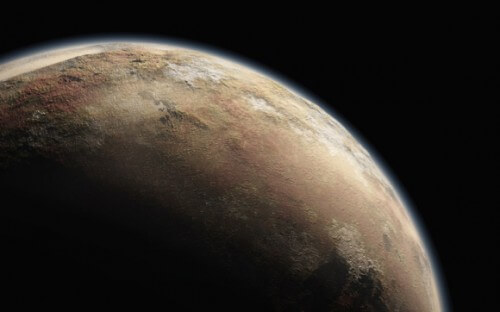At a press conference held by NASA last week, it presented the latest findings, and promised that every day the spacecraft will transmit more details until it reaches the nearest transit point in 10 weeks.

"We see land," said Dr. Alan Stern, the chief scientist of the New Horizons spacecraft in the first attempt to explain what is seen in the first clear images from Pluto transmitted by the New Horizons spacecraft, which is on its way to fly past it and its large moon Charon.
Almost 500 years ago, even Magellan who first circled the Earth for three years did not have to wait so long. However, ten years of travel are beginning to yield new details about the dwarf planet Pluto, formerly the ninth planet in the solar system. Recent images show features on Pluto's surface that may be polar caps.
Dr. John Grunsfeld, NASA's Deputy Administrator for Science Missions said that NASA's purpose is to "explore, discover and inspire" and added that New Horizons now meets exactly these three goals.
Dr. Stern, a researcher at the Serum West Research Institute in San Antonio, Texas, opened by expressing his excitement for the latest findings of the New Horizons Long Range Telescope, LORRI, but also for the team's efforts summing up decades of work.
"With 11 weeks to go and 98% of the way to Pluto, LORRI's halo images provide more detail than the best that could be achieved with the Hubble Space Telescope. It is impressive to discover signs of the existence of ice caps on the dwarf planet Pluto. And this without underestimating the importance of the telescope, which recently celebrated 25 years in space, and whose photographs helped plan the New Horizons mission.
According to Stern, the Pluto-Charon system is an impressive system. The first series of images transmitted by LPRRI in 2014 showed the gravitational dance of these two small bodies. According to him this is a real binary system of the kind we have not studied so far. Pluto and Charon are mutually dangerous through the tides. New Horizons is now viewing the sunlit side of these two bodies.
The Pluto-Charon system is tilted relative to the plane of its orbit around the Sun, explains Dr. Stern. "It's like watching Pluto spin on a spit." said. According to him, the more we see the surface, similar to the observer hovering over one of the Earth's poles when looking at the Earth and Moon system. The orbit of the two bodies as we can see from Lori's photo series looks elliptical, however due to the extremity of the system the orbits are perfect circles. New Horizons will eventually float slightly off center.
Dr. Stern goes on to explain that the latest images show lines on the surface of Pluto. "These signs point to the possible presence of ice caps" and he also emphasized that this is only a suggestion and that we must wait until New Horizons can transmit color and higher resolution images with the Ralph and Alice spectrometers to reveal the composition of these materials.
"New Horizons is like an airplane on its way to landing, but unlike an airplane, it cannot slow down. It has no counter rockets, and no fuel to decelerate from the trajectory that would take it out of the Sun's gravitational range. It will join the four Pioneer and Voyager spacecraft, which are the first man-made objects to leave the solar system. In preparation for the approach, each day that passes the spacecraft will close in on Pluto and Charon and Pluto will provide images that will fill all the detectors. The level of photography will be equivalent to watching from space in the pools in the center of Central Park in New York.
For the full story and more photos - on the Universe Today website

2 תגובות
http://www.nasa.gov/multimedia/imagegallery/image_feature_956.html
Where can I see the pictures?
And why do you always put a single picture and it is not related to the article either. Just want to fill the page?